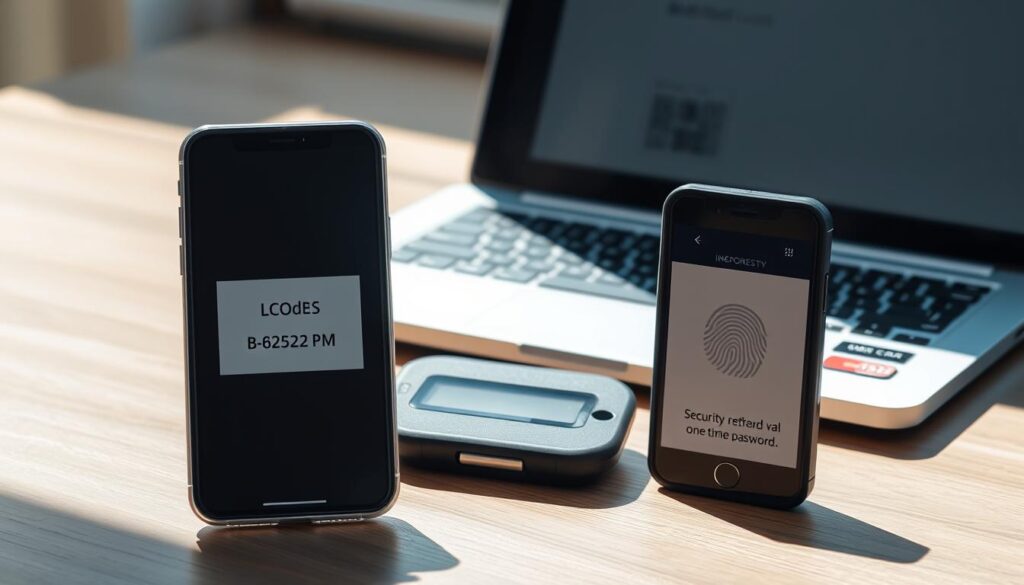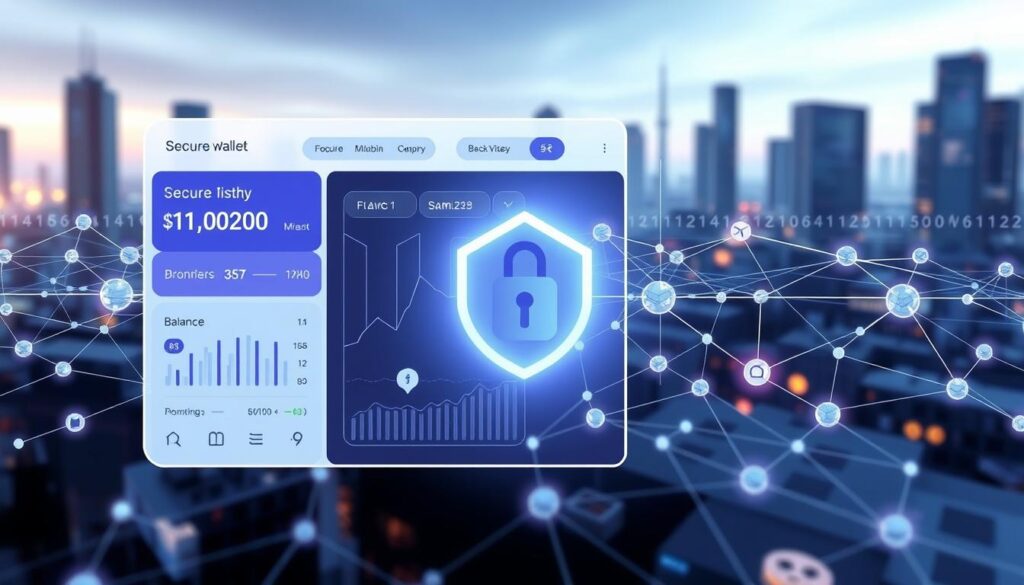Cybercriminals stole over $35 million in crypto from a single platform during one weekend in June 2023. This wasn’t an isolated event. Earlier that year, high-profile breaches affected users of MyAlgo and Trust Wallet, with losses exceeding $14 million combined. Even tech-savvy individuals like Kevin Rose, founder of Proof, fell victim to attacks losing valuable NFTs.
Unlike traditional bank accounts, crypto transactions can’t be reversed. Once hackers access your holdings, recovery options vanish. Recent incidents prove that basic password protection isn’t enough against sophisticated phishing schemes or key-logging malware.
This resource outlines essential strategies to shield your investments. We’ll analyze real-world breaches to reveal common vulnerabilities and provide actionable solutions. From multi-layer authentication to cold storage options, you’ll learn how to build robust defenses against evolving threats.
Key Takeaways
- Major crypto platforms suffered multimillion-dollar breaches in 2023
- Stolen digital funds typically can’t be recovered
- Attack methods range from phishing to direct key compromises
- Basic security measures often fail against modern threats
- Proactive protection strategies dramatically reduce risks
Understanding Crypto Wallets and Their Core Components
Many people think digital wallets work like bank vaults, but they’re more like sophisticated keychains. These tools don’t hold actual coins or tokens – they manage access codes that prove ownership on decentralized networks. Let’s break down what makes them tick.
Defining Wallets: Public and Private Keys
Every digital storage system uses two types of codes: public and private. Your public code acts like a mailbox address – share it freely to receive funds. The private code functions as a unique signature that unlocks outgoing transfers. Lose control of this secret number, and you lose everything it protects.
| Feature | Public Key | Private Key |
|---|---|---|
| Purpose | Receiving funds | Sending funds |
| Visibility | Shared openly | Never revealed |
| Security Role | Account identifier | Transaction authorizer |
How Wallets Interact with the Blockchain
These storage tools constantly communicate with network ledgers. When you check your balance, the system scans the entire transaction history linked to your public code. For those exploring options, our guide to the most secure digital storage solutions compares top-rated systems.
Think of it like email software reading messages from a server. Your wallet shows what’s happening on the chain but doesn’t store the actual assets. This setup explains why losing access codes means losing funds – there’s no central authority to reset your credentials.
Hot Wallets vs. Cold Wallets: Evaluating Storage Options
Digital asset holders face a critical choice: prioritize convenience or maximum protection for their holdings. Online-based systems and offline devices each serve distinct purposes in managing digital wealth.

When Speed Meets Vulnerability
Hot wallets like MetaMask and Phantom operate through browsers or apps. They excel for active trading with instant access to decentralized exchanges. These tools support thousands of tokens and integrate seamlessly with Web3 platforms.
Three key trade-offs emerge:
- Zero setup costs versus exposure to phishing attacks
- 24/7 accessibility balanced against partial control
- Broad crypto compatibility offset by reliance on internet connections
The Offline Advantage
Cold storage devices like Ledger Nano S create air-gapped protection. Transactions require physical confirmation on the device itself. While less convenient for daily use, they eliminate remote hacking risks.
| Factor | Hot Wallets | Cold Wallets |
|---|---|---|
| Access Speed | Instant | Manual |
| Attack Surface | High | Near Zero |
| Cost | Free | $50-$200 |
Smart users often split holdings – keeping 5-10% in hot wallets for liquidity while securing the majority offline. This hybrid approach balances trading flexibility with long-term safety.
Identifying Common Threats and Risks in Crypto Security
Digital asset protection demands constant vigilance as attackers refine their strategies daily. Two primary dangers dominate the landscape: deceptive human manipulation and flawed technical safeguards.

Phishing Attacks and Social Engineering
Fraudsters increasingly pose as trusted services to bypass defenses. Dominic Lacovone lost $650,000 after hackers impersonated Apple Support to steal his MetaMask recovery phrase. Similarly, RTKFT’s COO Nikhil Gopalani surrendered $175,000 in NFTs through a compromised Apple ID.
These phishing attacks succeed by exploiting urgency and familiarity. Attackers send fake alerts about account locks or verification needs, directing victims to cloned login pages. Once credentials are entered, funds disappear within minutes.
Vulnerabilities in Key Management Systems
Centralized storage of sensitive data creates systemic risks. The 2022 Slope breach exposed how some platforms keep mnemonic phrases in server logs. Hackers exploited this oversight, draining $4 million from users.
Three critical flaws enable such attacks:
- Storing seed phrases on internet-connected servers
- Using unencrypted backup systems
- Failing to audit third-party software integrations
| Threat Type | Method | Impact | Prevention |
|---|---|---|---|
| Phishing | Fake support calls | Direct fund theft | Hardware authentication keys |
| Key Management | Server-side storage | Mass breaches | Offline phrase storage |
Understanding these threats helps users avoid costly mistakes. Always verify service requests through official channels and never store recovery phrases digitally. For crypto security, assume every unsolicited message could be hostile.
Cryptocurrency Wallet Security Best Practices Guide
Effective protection starts with layered verification systems. Modern tools offer multiple barriers against unauthorized entry, but users often underestimate their importance until breaches occur.

Implementing Two-Factor Authentication (2FA)
Two-step verification blocks 99.9% of automated attacks according to Microsoft research. Authenticator apps like Google Authenticator generate time-sensitive codes that expire within 30 seconds. This method proves safer than SMS-based systems vulnerable to SIM-swapping scams.
| Method | Security Level | Convenience |
|---|---|---|
| SMS Codes | Basic | High |
| Authenticator Apps | Advanced | Medium |
| Hardware Keys | Maximum | Low |
Creating and Managing Strong, Unique Passwords
Most users reuse simple phrases across multiple platforms – a critical mistake. Password managers like 1Password create 20-character combinations mixing letters, numbers, and symbols. These tools encrypt credentials locally before syncing across devices.
| Strategy | Risk Level | Example |
|---|---|---|
| Personal Info | Extreme | John1985! |
| Random Phrases | Moderate | BlueSky$Run42 |
| Generated Strings | Minimum | 9q#V7Lm!pR2@zW5 |
Always enable 2FA first on email and financial accounts. For detailed implementation guides, review comprehensive security protocols covering multi-platform setups. Combine biometric logins with hardware tokens for high-value assets.
Advanced Techniques to Protect Your Digital Assets
Organizations managing shared funds face unique challenges in securing high-value holdings. Sophisticated users now employ layered strategies that combine transaction protocols with compartmentalized storage systems.
Adopting Multi-Signature Wallets
Multi-sig systems require approval from 3-5 authorized parties before moving funds. This approach prevents single-person errors and deters internal fraud. DAOs like MakerDAO use these setups to manage treasury reserves worth billions.
| Feature | Single-Signature | Multi-Signature |
|---|---|---|
| Approval Required | 1 person | 3+ people |
| Hacker Resistance | Low | Extreme |
| Ideal For | Personal use | Teams/Organizations |
Using Burner Wallets for Risk Management
Separate accounts for experimental activities keep primary holdings safe. Create temporary addresses for:
- Airdrop registrations
- New platform testing
- Suspicious website connections
When Uniswap launched its V3 upgrade, savvy traders used burner accounts to interact with the untested interface. This practice limited potential losses to small amounts if vulnerabilities existed.
Transfer only necessary crypto to burner systems, and never store recovery phrases digitally. Treat these accounts as disposable shields protecting your core digital assets from emerging threats.
Integrating Secure Wallet Management with Blockchain Technology
Smart contract systems are reshaping how users safeguard digital holdings through programmable rules. These next-generation tools automate protection measures while maintaining blockchain’s decentralized principles.

Account Types and Custom Protections
Two architectures dominate this space:
- Externally Owned Accounts (EOA): Accessed via seed phrases like traditional systems
- Contract Accounts: Governed by code-based rules requiring multiple approvals
Platforms like Argent demonstrate this evolution. Users can freeze accounts after suspicious activity or set daily spending limits – features borrowed from conventional banking but enforced through blockchain.
| Feature | EOA Wallets | Contract Wallets |
|---|---|---|
| Access Control | Single key | Multi-party rules |
| Recovery Options | Seed phrase only | Guardian networks |
| Transaction Limits | None | Programmable |
Gnosis Safe takes this further with customizable approval workflows. Teams managing crypto reserves often require 3/5 signatures for transfers, preventing unilateral actions. These systems integrate seamlessly with DeFi platforms while adding enterprise-grade safeguards.
As blockchain technology matures, expect more hybrid solutions blending automated security with user-friendly interfaces. The key lies in balancing flexibility against potential smart contract vulnerabilities – a challenge developers continue addressing through rigorous code audits.
Staying Vigilant: Regular Updates and Safe Online Practices
A 2023 Verizon report revealed 60% of data breaches involved unpatched vulnerabilities. Outdated systems act as open doors for hackers targeting digital assets. Developers release patches to fix newly discovered gaps – ignoring these updates leaves your defenses incomplete.
Importance of Software and Browser Updates
Modern web browsers process sensitive data like login credentials and transaction details. Outdated versions lack critical protections against malicious scripts. Always enable automatic updates for:
- Operating systems
- Browser extensions
- Account management apps
| Update Status | Risk Level | Attack Prevention |
|---|---|---|
| Current (≤30 days) | Low | Blocks 92% of exploits |
| Outdated (>90 days) | Critical | 0% protection |
Safe Practices When Using Public Wi-Fi
Coffee shop networks expose users to man-in-the-middle attacks. Hackers intercept unencrypted traffic to harvest login details. Follow these protocols when accessing accounts remotely:
| Action | Secure Method | Risk Reduced By |
|---|---|---|
| Network Choice | Personal hotspot | 78% |
| Data Encryption | VPN with AES-256 | 95% |
Never check balances or approve transactions on shared networks without protection. Reputable VPN services mask your IP address and encrypt all transmitted information. For maximum security, pair VPNs with firewall-enabled devices.
Final Insights on Keeping Your Crypto Secure
Protecting digital holdings requires adapting to evolving risks while maintaining accessibility. Recent breaches prove that static defenses crumble against sophisticated attacks. The solution lies in layered strategies combining technology with disciplined habits.
Cold storage remains vital for long-term holdings, while multi-signature setups add accountability for shared funds. Always separate daily-use accounts from savings – like keeping cash in different bank envelopes. This limits exposure if one system gets compromised.
Treat authentication tools as your first line of defense. Authenticator apps and hardware keys outperform SMS verification. Pair these with auto-generated passwords stored in encrypted managers. Never reuse login details across platforms.
Public networks demand extra caution. Assume every coffee shop router hides unseen threats. Use VPNs to mask activity and avoid checking balances on shared devices. Bookmark trusted websites to sidestep fake links in phishing emails.
Remember: digital assets can’t be recovered like stolen credit cards. Regular security audits and offline backups of recovery phrases ensure you stay in control. Balance convenience with protection, and your holdings will weather the storm of emerging threats.


No comments yet